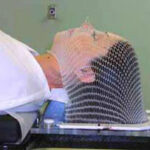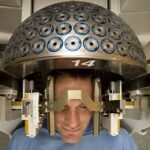People are more familiar with the word Gamma Knife because it’s been around longer than the CyberKnife, which makes it more antiquated, an older version of stereotactic radiosurgery. When considering which treatment to choose, consider, do you want an older version, or a newer, much improved version of radiation therapy?
While there are many comparisons to the Gamma Knife, the CyberKnife System is the only dedicated stereotactic radiosurgery (SRS) treatment technology that also can be used to deliver stereotactic body radiation therapy (SBRT) for treatments throughout the body.
Both the CyberKnife System and Gamma Knife are used to deliver stereotactic radiosurgery (SRS) treatments to address tumors, vascular lesions, and functional disorders, such as trigeminal neuralgia or an arteriovenous malformation (AVM), which is a tangle of blood vessels that irregularly connects arteries and veins, disrupting blood flow and oxygen circulation from the heart to the brain and other organs.
Both Gamma Knife and CyberKnife treatments are designed to treat inoperable or recurrent brain tumors, and can be used for patients who do not want to endure the risks of surgery. However, there are some crucial differences between Gamma Knife and CyberKnife.

CyberKnife: Non-invasive treatment. Utilizes a soft mesh mask to ensure patient’s comfort and positioning during treatment.
Sub-millimeter accuracy, enabled by sophisticated robotic radiation delivery, and real-time imaging and tumor-tracking technology which compensates for any tumor or patient movement.
Offers flexibility in treatments – from a single, precisely delivered high-dose to 2 to 5 lower dose treatments deliverd by a flexible robotic arm. Both approaches minimize damage to surrounding tissue, nerves and vessels, as well as side effects.
No anesthesia required.

Gamma Knife: Invasive procedure that requires a large metal head frame secured by screws into the skull.
Sub-millimeter accuracy aided by invasive head frame to minimize patient movement.
Because of the head frame, patients are limited to a single, high dose treatment, dilivered from a fixed number of angles, which can limit the sparing of surrounding healthy tissues and cause side effects.
Can require general or local anesthesia.
Understanding CyberKnife And Gamma Knife Procedures
Before deciding on your treatment, it’s important to understand the differences between CyberKnife and Gamma Knife treatments. The Gamma Knife requires patients to be fitted with a head frame that is bolted into the skull. The CyberKnife System is non-invasive. It relies on sophisticated, real-time motion tracking technology than enables the robotic arm to accurately compensate for patient movement. CyberKnife patients need only to be fitted with a soft, plastic mesh mask to assist in positioning during treatment, which results in a much more comfortable treatment experience.
Another drawback of the Gamma Knife procedure is the time constraint. Because of the head frame required for Gamma Knife procedures, all imaging, treatment plans and treatment must happen on the same day. The head frame is usually mounted to the patient’s skull in the morning, followed by scans to map out the position of the tumor. Patients must then wait in the hospital with the head frame in place while the treatment planning process occurs. Once the planning process is complete, which may take up to several hours, the patient and head frame is fixed to the table and a single radiation dose is administered to the tumor.
CyberKnife treatments are much more flexible. Imaging and scans are completed days before treatments, giving the radiation oncologist and physics team time to carefully design a customized treatment plan. Once the plans for treatment are finalized, the patient returns for a completely pain-free treatment experience. Since CyberKnife patients do not need a head frame, doctors are able to deliver smaller doses, with extreme accuracy, over the course of two to five days to benefit the patient. This approach enables the patient to receive the same total dosage to his or her tumor, but significantly limiting the side effects associated with delivery of a single, high dose of radiation, as the Gamma Knife requires. Clinical data has shown that for certain cancerous and non-cancerous conditions, a lower dose of fractionated radiosurgery results in a better response than a single large dose.
Another factor to consider is the different ways radiation is delivered. Gamma Knife uses high-intensity radiation therapy that concentrates radiation to a single targeted area. This approach is meant to kill cancer cells and shrink tumors without harming surrounding healthy tissue. The Gamma Knife approach entails delivering multiple, radiation beams simultaneously to the target area or tumor location. The CyberKnife System, on the other hand, applies a single, high-energy photon beam directly to the exact target area. The CyberKnife offers greater treatment flexibility as a result of its robotic arm, and real-time motion tracking technology, allowing doctors to deliver high doses or radiation with pinpoint precision from virtually any angle around the patient.
CyberKnife Advantages
While both technologies can precisely treat cancerous and non-cancerous tumors, the CyberKnife System has distinct advantages, beyond those mentioned above. The CyberKnife System can treat tumors in the brain, head, neck, and throughout the body. The Gamma Knife, however, is limited to cancers in the brain and limited cervical spine areas, where movement can be stabilized with invasive head frames. Because of its more advanced technology, the CyberKnife System can treat tumors in organs of the body that move with normal breathing by utilizing real-time imaging of the targeted location.
The revolutionary changes in non-invasive treatments, such as those offered by the CyberKnife System, enable our clinicians to effectively target cancer that has spread to other parts of the body, such as the lung, prostate, liver, pancreas and kidney. The CyberKnife System also can treat recurrent tumors, targeting them from thousands of different angles and limiting the exposure of surrounding healthy tissue in ways that the more limited, conventional Gamma Knife is unable to do.
All CyberKnife treatments include multiple imaging of the tumor in real time. Gamma Knife procedures utilize static images that were taken in advance of treatment to determine the location of the tumor, and are not updated in real-time and cannot take into account for normal movement of the tumor or patient anatomy.
If you would like more information on both of these treatment options, contact the top cancer experts in Miami at 305-279-2900.
